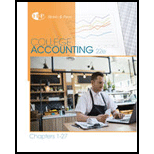
College Accounting, Chapters 1-27
23rd Edition
ISBN: 9781337794756
Author: HEINTZ, James A.
Publisher: Cengage Learning,
expand_more
expand_more
format_list_bulleted
Question
Chapter 24, Problem 6SEB
To determine
Compute Return on equity during the period 20-2 using its three components.
Expert Solution & Answer
Trending nowThis is a popular solution!

Students have asked these similar questions
What is the overhead applied in COGS for job X5? Accounting question
During its first year. Raymond, Inc., showed a $33 per unit profit under absorption costing but would have reported a total profit of $19,300 less under variable costing. If production exceeded sales by 825 units and an average contribution margin of 77% was maintained, what is apparent: a. Fixed cost per unit? b. Sales price per unit?
General accounting
Chapter 24 Solutions
College Accounting, Chapters 1-27
Ch. 24 - A comparison of amounts for the same item in the...Ch. 24 - Prob. 2TFCh. 24 - Prob. 3TFCh. 24 - Prob. 4TFCh. 24 - Prob. 5TFCh. 24 - Prob. 1MCCh. 24 - Prob. 2MCCh. 24 - Working capital is a measure of (a) liquidity. (b)...Ch. 24 - Prob. 4MCCh. 24 - Prob. 5MC
Ch. 24 - Prob. 1CECh. 24 - Prob. 2CECh. 24 - Compute the following profitability measures for...Ch. 24 - Prob. 4CECh. 24 - Prob. 5CECh. 24 - Prob. 6CECh. 24 - Prob. 1RQCh. 24 - Prob. 2RQCh. 24 - Prob. 3RQCh. 24 - Prob. 4RQCh. 24 - Prob. 5RQCh. 24 - Prob. 6RQCh. 24 - Prob. 7RQCh. 24 - Prob. 8RQCh. 24 - Prob. 9RQCh. 24 - Prob. 10RQCh. 24 - Prob. 11RQCh. 24 - Prob. 12RQCh. 24 - Prob. 13RQCh. 24 - Prob. 1SEACh. 24 - Prob. 2SEACh. 24 - ANALY SIS OF PROFITABILITY Based on the financial...Ch. 24 - ANALY SIS OF LEVERAGE Based on the financial...Ch. 24 - Prob. 5SEACh. 24 - Prob. 6SEACh. 24 - Prob. 7SEACh. 24 - Prob. 8SPACh. 24 - Prob. 9SPACh. 24 - RATIO ANALY SIS OF COMPARATI VE FIN ANCIAL STATE...Ch. 24 - Prob. 1SEBCh. 24 - Prob. 2SEBCh. 24 - Prob. 3SEBCh. 24 - Prob. 4SEBCh. 24 - Prob. 5SEBCh. 24 - Prob. 6SEBCh. 24 - Prob. 7SEBCh. 24 - Prob. 8SPBCh. 24 - Prob. 9SPBCh. 24 - RATIO ANALY SIS OF COMPARATI VE FIN ANCIAL STATE...Ch. 24 - Prob. 1MPCh. 24 - This problem challenges you to apply your...
Knowledge Booster
Learn more about
Need a deep-dive on the concept behind this application? Look no further. Learn more about this topic, accounting and related others by exploring similar questions and additional content below.Similar questions
- Can you solve this general accounting problem using accurate calculation methods?arrow_forwardI need help with this general accounting problem using proper accounting guidelines.arrow_forwardOn January 1, 2025, Wages Payable was $51,000. Wages Expenses for 2025 totaled $463,000. The ending balance of Wages Payable was $55,000. What is the amount of cash paid for wages in 2025? Provide answerarrow_forward
- On June 1, 2018, Rivera Corp. issued $3,500,000 of 12% nonconvertible bonds at 102, due on May 31, 2028. Each $3,000 bond was issued with 52 detachable stock warrants, each of which entitled the holder to purchase, for $75, one share of Rivera's $50 par common stock. On June 1, 2018, the market price of each warrant was $9. By what amount should the bond issue proceeds increase shareholders' equity?arrow_forwardI need help with this general accounting problem using proper accounting guidelines.arrow_forwardJemson Enterprises reported net fixed assets of $3.6 million on its 2023 balance sheet and $3.4 million on its 2022 balance sheet. The 2023 income statement reported a depreciation expense of $300,000. How much did Jemson spend to acquire new fixed assets during 2023? Answerarrow_forward
arrow_back_ios
SEE MORE QUESTIONS
arrow_forward_ios
Recommended textbooks for you
 College Accounting, Chapters 1-27AccountingISBN:9781337794756Author:HEINTZ, James A.Publisher:Cengage Learning,
College Accounting, Chapters 1-27AccountingISBN:9781337794756Author:HEINTZ, James A.Publisher:Cengage Learning, Financial And Managerial AccountingAccountingISBN:9781337902663Author:WARREN, Carl S.Publisher:Cengage Learning,
Financial And Managerial AccountingAccountingISBN:9781337902663Author:WARREN, Carl S.Publisher:Cengage Learning, Managerial AccountingAccountingISBN:9781337912020Author:Carl Warren, Ph.d. Cma William B. TaylerPublisher:South-Western College Pub
Managerial AccountingAccountingISBN:9781337912020Author:Carl Warren, Ph.d. Cma William B. TaylerPublisher:South-Western College Pub- Century 21 Accounting Multicolumn JournalAccountingISBN:9781337679503Author:GilbertsonPublisher:Cengage
 College Accounting (Book Only): A Career ApproachAccountingISBN:9781305084087Author:Cathy J. ScottPublisher:Cengage Learning
College Accounting (Book Only): A Career ApproachAccountingISBN:9781305084087Author:Cathy J. ScottPublisher:Cengage Learning College Accounting (Book Only): A Career ApproachAccountingISBN:9781337280570Author:Scott, Cathy J.Publisher:South-Western College Pub
College Accounting (Book Only): A Career ApproachAccountingISBN:9781337280570Author:Scott, Cathy J.Publisher:South-Western College Pub

College Accounting, Chapters 1-27
Accounting
ISBN:9781337794756
Author:HEINTZ, James A.
Publisher:Cengage Learning,

Financial And Managerial Accounting
Accounting
ISBN:9781337902663
Author:WARREN, Carl S.
Publisher:Cengage Learning,

Managerial Accounting
Accounting
ISBN:9781337912020
Author:Carl Warren, Ph.d. Cma William B. Tayler
Publisher:South-Western College Pub

Century 21 Accounting Multicolumn Journal
Accounting
ISBN:9781337679503
Author:Gilbertson
Publisher:Cengage

College Accounting (Book Only): A Career Approach
Accounting
ISBN:9781305084087
Author:Cathy J. Scott
Publisher:Cengage Learning

College Accounting (Book Only): A Career Approach
Accounting
ISBN:9781337280570
Author:Scott, Cathy J.
Publisher:South-Western College Pub
ACCOUNTING BASICS: Debits and Credits Explained; Author: Accounting Stuff;https://www.youtube.com/watch?v=VhwZ9t2b3Zk;License: Standard Youtube License